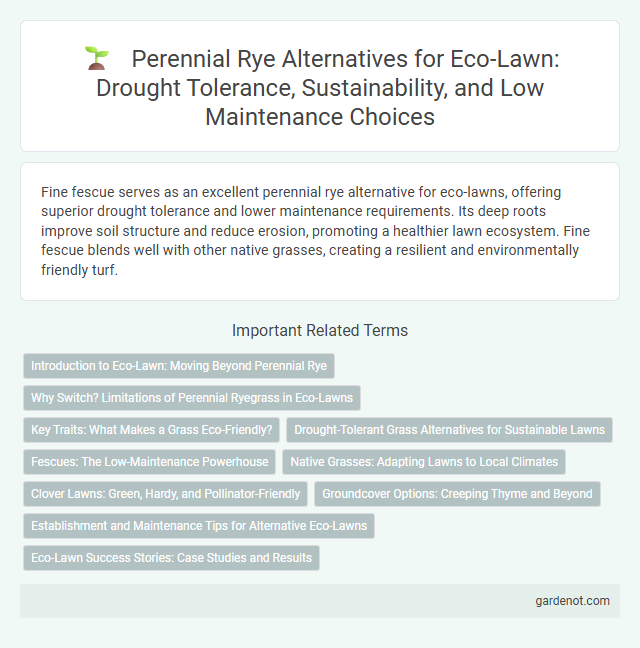Fine fescue serves as an excellent perennial rye alternative for eco-lawns, offering superior drought tolerance and lower maintenance requirements. Its deep roots improve soil structure and reduce erosion, promoting a healthier lawn ecosystem. Fine fescue blends well with other native grasses, creating a resilient and environmentally friendly turf.
Introduction to Eco-Lawn: Moving Beyond Perennial Rye
Eco-Lawn offers a sustainable alternative to traditional perennial rye, utilizing low-maintenance, drought-resistant grasses that require less fertilizer and water. This eco-friendly lawn option supports biodiversity by promoting native plant species and reducing chemical inputs. Its resilient turf withstands foot traffic while enhancing soil health and carbon sequestration in residential landscapes.
Why Switch? Limitations of Perennial Ryegrass in Eco-Lawns
Perennial ryegrass, while popular for its rapid germination and lush appearance, struggles with high maintenance requirements and poor drought tolerance in eco-lawns. Its shallow root system limits soil stabilization and reduces resilience to environmental stress compared to deeper-rooted alternatives like fine fescues or buffalo grass. Switching to these more sustainable species improves water efficiency, enhances biodiversity, and supports long-term lawn health in eco-friendly landscaping.
Key Traits: What Makes a Grass Eco-Friendly?
Fine fescue is an ideal perennial rye alternative for eco-lawns due to its low water requirements, deep root system, and natural resistance to pests and diseases, which reduce the need for chemical inputs. It maintains a dense, green cover with minimal mowing and thrives in poor soil conditions, promoting soil health and biodiversity. Its ability to withstand drought and shade enhances sustainability, making it a highly eco-friendly grass choice.
Drought-Tolerant Grass Alternatives for Sustainable Lawns
Tall fescue is a drought-tolerant perennial rye alternative known for its deep root system that ensures resilience during dry conditions, making it ideal for sustainable lawns. Buffalo grass requires minimal water and maintenance, thriving in hot climates while reducing irrigation needs significantly. Fine fescue species offer shade tolerance and low nutrient requirements, contributing to eco-friendly lawn solutions that conserve water and support biodiversity.
Fescues: The Low-Maintenance Powerhouse
Fescues, particularly fine fescue varieties, serve as a low-maintenance powerhouse alternative to perennial ryegrass for eco-lawns due to their drought tolerance, shade adaptability, and slow growth rate, which reduces the need for frequent mowing. Their deep root systems improve soil stability and decrease erosion while requiring significantly less water, making them ideal for sustainable landscaping. Integrating fescues into eco-lawn mixes enhances resilience against pests and diseases, promoting a healthier, eco-friendly turf.
Native Grasses: Adapting Lawns to Local Climates
Native grasses like buffalo grass, blue grama, and sideoats grama offer a sustainable alternative to perennial rye for eco-lawns, thriving in local climates with minimal water and maintenance. These grasses improve soil health, enhance biodiversity, and provide resistance to pests and drought. Choosing native species supports regional ecosystems and ensures long-term lawn resilience and environmental benefits.
Clover Lawns: Green, Hardy, and Pollinator-Friendly
Clover lawns offer a sustainable and resilient alternative to perennial ryegrass, thriving in various soil conditions while requiring less water and fertilizer. Their deep-root systems improve soil health and enhance drought resistance, making them a practical choice for eco-friendly landscaping. Clover also attracts pollinators such as bees and butterflies, supporting local biodiversity and promoting a vibrant garden ecosystem.
Groundcover Options: Creeping Thyme and Beyond
Creeping thyme offers a resilient, drought-tolerant groundcover alternative to perennial rye, thriving in well-drained soils and attracting pollinators with its vibrant blossoms. Other viable options include creeping phlox, which provides a colorful carpet and suppresses weeds, and sedum, known for its succulent leaves and low-maintenance growth. These eco-friendly groundcovers require less water and fertilizer, contributing to sustainable landscaping practices while enhancing biodiversity.
Establishment and Maintenance Tips for Alternative Eco-Lawns
Tall fescue serves as a viable perennial rye alternative for eco-lawns, offering deep root systems that enhance drought resistance and soil stability. Establishment requires well-prepared seedbeds, moderate watering during germination, and avoiding heavy foot traffic for the first few weeks. Maintenance includes mowing at a height of 3 to 4 inches, infrequent irrigation during dry spells, and periodic aeration to promote healthy growth and reduce thatch buildup.
Eco-Lawn Success Stories: Case Studies and Results
Tall fescue serves as an excellent eco-lawn perennial rye alternative, demonstrating superior drought tolerance and low maintenance needs in urban landscaping. Case studies from eco-lawn projects in California and Texas reveal significant reductions in water consumption and improved soil health using tall fescue blends. These success stories highlight the grass's resilience and cost-effectiveness, making it a preferred choice for sustainable lawn solutions.
Perennial rye alternative Infographic

 gardenot.com
gardenot.com